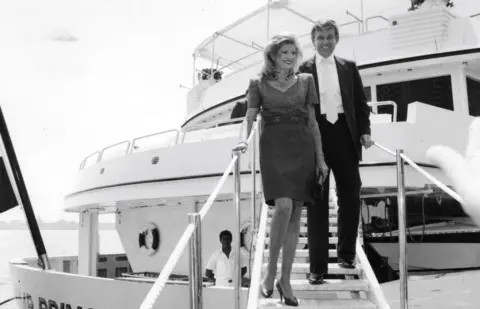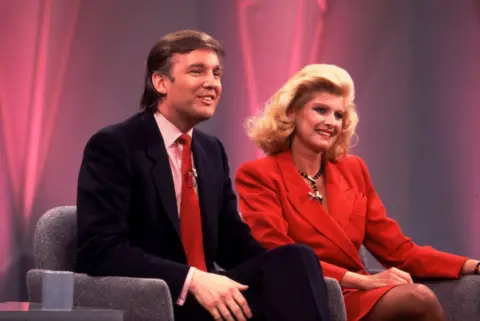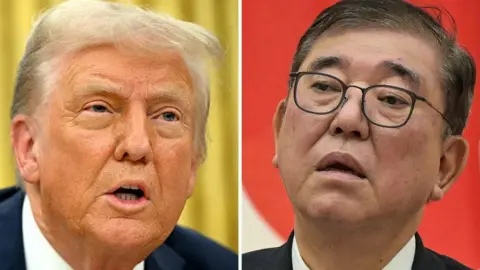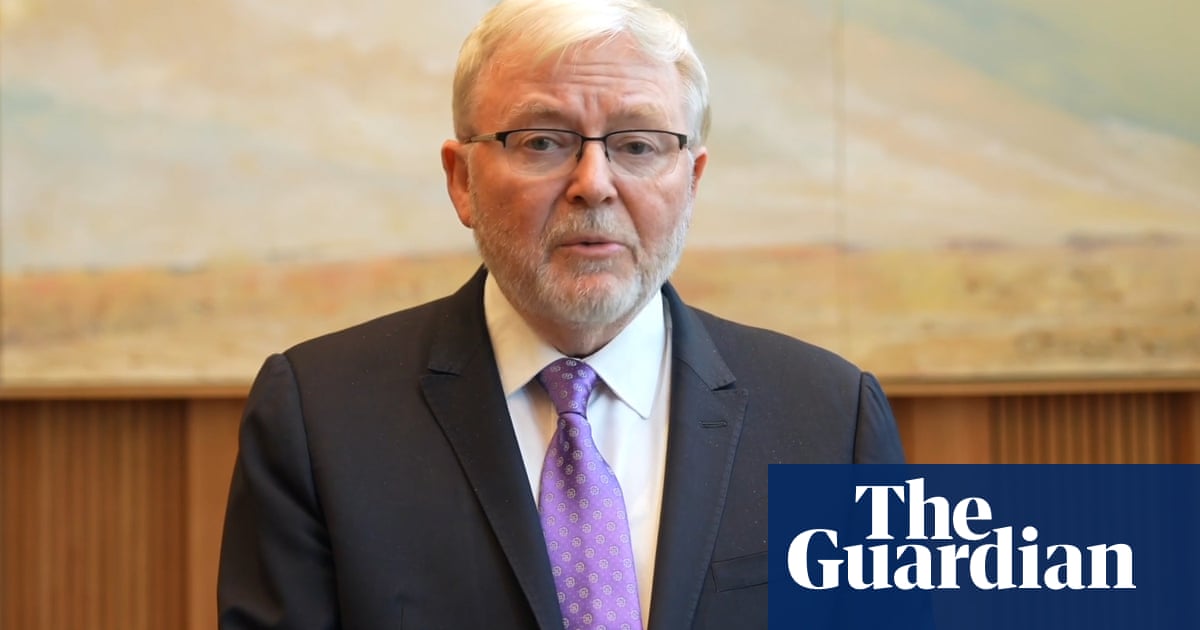New York correspondent

 Getty Images
Getty ImagesWhen Donald Trump’s fortunes took a downturn in the 90s and he needed to raise cash fast, he sailed his 282ft (85m) superyacht, the Trump Princess, to Asia hoping he could attract Japan’s wealthy.
It wasn’t the first time the businessman had sought out Japanese buyers or lenders for his projects.
In the cut-throat world of New York real estate, Trump had a front-row seat from his Fifth Avenue skyscraper of Tokyo’s buying spree in the 80s of iconic US brands and properties, including Rockefeller Center.
It was then that his worldview on trade and America’s relations with its allies was formed, and his fixation on tariffs, a tax on imports, began.
“He had a tremendous resentment for Japan,” says Barbara Res, a former executive vice-president at the Trump Organization.
He watched with jealousy as Japanese businessmen were viewed as geniuses, she says. He felt America wasn’t getting enough in return for assisting its ally Japan with military defence.
Trump often complained that he had difficulties doing deals with large groups of Japanese businessmen.
“I’m tired of watching other countries ripping off the United States.”
That Trump quote could’ve been pulled from 2016, but it’s actually from the late 80s when he made an appearance on CNN’s Larry King Live, around the time he first floated his name as a potential presidential candidate.
Fresh from sharing his business philosophy in his 1987 book, The Art of the Deal, Trump went on a tirade against America’s trade policies in national interviews.
In an animated interview with Oprah Winfrey before a live studio audience on The Oprah Show, he said he would handle foreign policy differently by making the country’s allies “pay their fair share”.
He added that there wasn’t free trade when Japan was “dumping” products into America’s market but making it “impossible to do business” there.

 Getty Images
Getty ImagesJennifer Miller, an associate professor of history at Dartmouth College, said others shared his concerns about the economy at the time.
Japan provided competition for US manufacturing, particularly in consumer electronics and cars. As US factories were shuttering and new Japanese brands entered the market, pundits were talking about Japan surpassing the US as the world’s leading economy.
“Trump is sort of symbolic of a lot of people who were kind of questioning American leadership in the American-led international order, and whether it actually served the United States,” Prof Miller says.
Before his Oprah appearance, Trump had spent almost $100,000 to release an “open letter” in full-page ads in three major US newspapers.
The headline read: “There’s nothing wrong with America’s Foreign Defense Policy that a little backbone can’t cure.”
In it, he said Japan and other nations had been taking advantage of the US for decades. He claimed “the Japanese, unimpeded by the huge costs of defending themselves (as long as the United States will do it for free), have built a strong and vibrant economy with unprecedented surpluses”.
Trump believed the obvious solution was to “tax” these wealthy nations.
“The world is laughing at America’s politicians as we protect ships we don’t own, carrying oil we don’t need, destined for allies who won’t help,” he wrote.
More on Trump tariffs
The ad served as a potent introduction to Trump’s foreign policy vision, according to Prof Miller. One built on the zero-sum belief that allies are freeloaders and that the liberal internationalist approach which had dominated since World War II was weak and foolish in a competitive world. The solution, he argued, was a more aggressive, protectionist trade policy.
“I think that’s one reason he likes tariffs so much, is they fit not only with his transactional ideology but his sense of himself, which is very deeply rooted as this successful dealmaker,” she said. “And the fact that tariffs can be threatened; they can be dangled over another country.”
Clyde Prestowitz headed negotiations with Japan during the Reagan administration as counselor to the secretary of commerce. A longtime critic of free-trade policies, he said nobody who was intellectually serious was affiliated with Trump or his simplistic approach at the time. He argues that the president hasn’t offered a real solution to the problems he’s raised.
“Tariffs are kind of a showy thing that you can say, look what I did, I banged those guys… so you know, you can be a tough guy. Whether or not they are effective in any way is really open to discussion.”
Mr Prestowitz believes the real problem then and now is that the US doesn’t have a strategic manufacturing policy, despite complaining about unfair trade.
Of course, fears of Japan’s rise calmed over time and now it’s an ally. Instead it’s China that is the US’s fiercest corporate competitor. This week Trump welcomed Japan’s prime minster into the Oval Office as one of his first foreign visitors.

 Getty Images
Getty ImagesBut Donald Trump’s governing philosophy is still the same as when he was a young real estate developer. He still believes just as strongly in tariffs as a tool to pressure other countries to open their markets and reduce trade deficits.
“He just says this all the time to anybody who will listen whenever anybody asks, and that’s been true for 40 years. And in fairness to him, you know that is a very natural way to view international commerce,” said Michael Strain, an economist with the conservative American Enterprise Institute.
He says students often share Trump’s intuitive thinking about the economy, and one of the big challenges that professors face is convincing them that their understanding is wrong.
Mr Strain says despite Trump’s hold on the party, with a stance that has upended decades of Republican embrace of free trade, he doesn’t think he’s convinced sceptical lawmakers, business leaders and economists.
The sticking points remain that his views that foreign imports are bad, that the size of the trade deficit is a useful measure of policy success or that the ideal state for the US economy is to only import goods that cannot physically be made in the US.
Mr Strain believes threats to increase tariffs on US allies could reduce business investment and weaken international alliances.
Joseph LaVorgna, a chief economist of the National Economic Council during Trump’s first term, believes there’s been too narrow a focus on tariffs and not enough of an attempt to understand the big picture of what Trump is trying to accomplish.
He says the president wants to galvanise domestic industry, in particular high-tech manufacturing.
The administration, he explains, feels they can encourage more corporations to come to the US using tariffs, combined with deregulation, cheaper energy and lower corporate taxes, if enacted by Congress.
“I think that President Trump understands something which is very important, being a businessman and being transactional, and that is free trade is great in theory but in the real world you need to have fair trade and that’s a level playing field.”
He is betting Donald Trump is right. Few Republicans have publicly opposed the president as he demands loyalty to his agenda.
Still, some who have remained silent understand that their constituents could be impacted by rising prices, and are hoping they can convince Trump not to follow through with his beloved tariffs.
Article by:Source:














